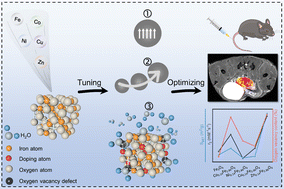Transition-metal-doped hydrophilic ultrasmall iron oxide modulates MRI contrast performance for accurate diagnosis of orthotopic prostate cancer†
Abstract
The FDA-approved iron oxide nanocrystals (IONs), as negative magnetic resonance imaging contrast agents (MRICAs), face challenges because of their low relaxation rate and coherent ferromagnetism. Although research has found that metal doping is an efficient approach to improve the magnetic property and MRI contrast performance of IONs, their systemic mechanism has not been fully explained. Herein, we fabricated a series of transition-metal-doped IONs and systemically explored their sizes, structures, and variation in magnetic properties, revealing the oxygen vacancy-mediated MRI contrast enhancement mechanism of transition-metal-doped IONs. Based on these, we found that Zn-doped IONs possess optimal T2 MRI contrast performance and further investigated their potential to diagnose in vivo orthotopic tumor as a T2 contrast agent. The results indicate that the use of Zn-doped IONs significantly enhances T2-weighted MRI signal intensity of orthotopic prostate tumor with low toxicity, which is beneficial for the accurate diagnosis of orthotopic tumor. Collectively, this work clearly illustrates the mechanism of contrast enhancement of transition-metal-doped IONs and provides a novel paradigm for developing a highly efficient T2 contrast agent.



 Please wait while we load your content...
Please wait while we load your content...